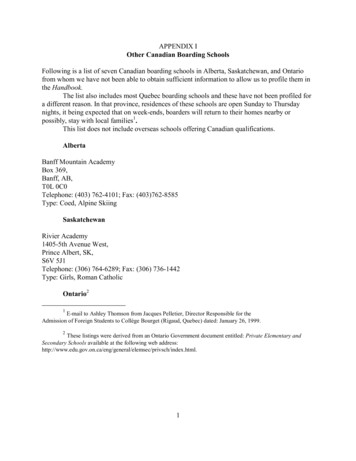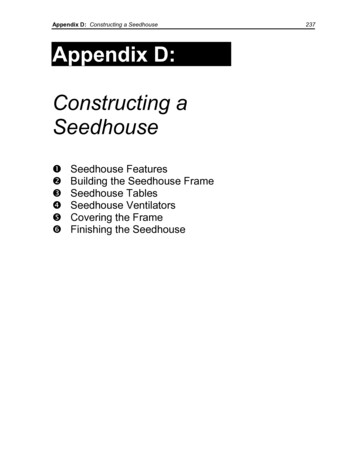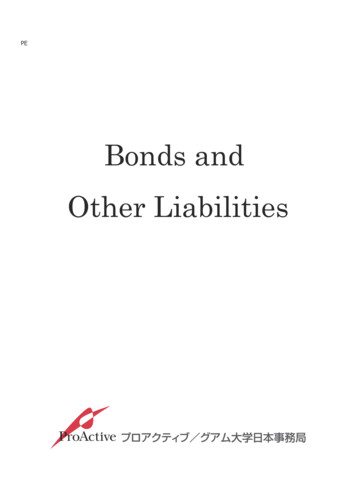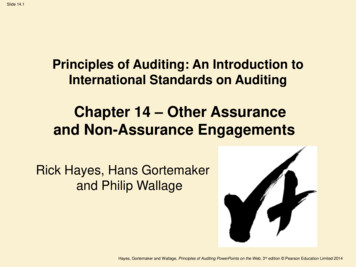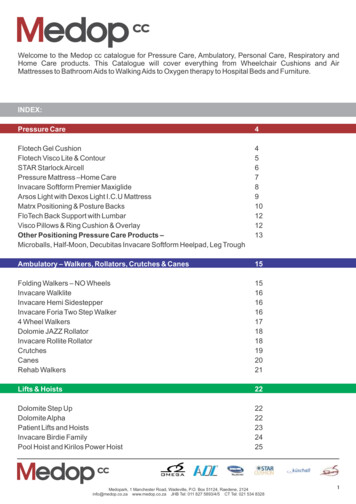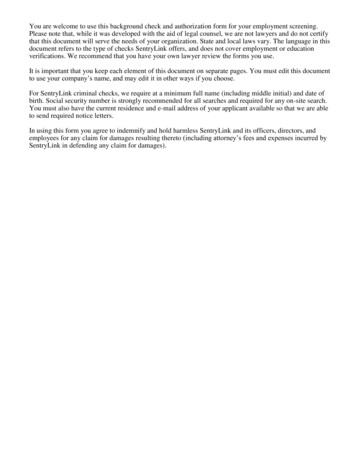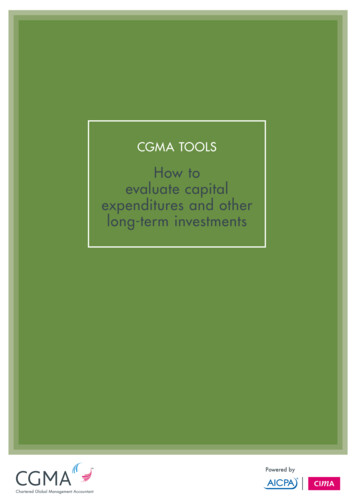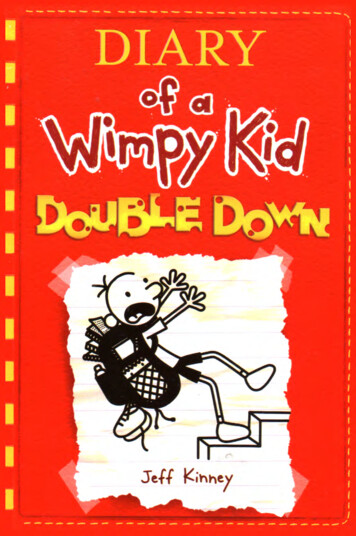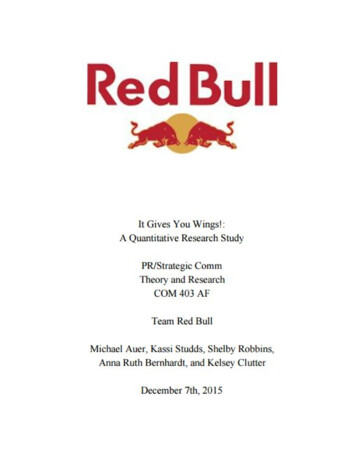
Transcription
Table of ContentsExecutive Summary 1Quantitative Research 2Introduction 2Problem Statement 3Research Objectives 4Concepts of Interest 4Research Method 5Findings 8Research Conclusions 10References 12Appendices 13Appendix A: Survey Questionnaire 13Appendix B: Results (Tables and Graphs) 13Appendix C: Other Materials 151
Executive SummaryWe began our research with the same problem statement as both our secondary and qualitativeresearch. This problem statement being:“Red Bull must expand its target audience beyond what they currentlyuse in order to capitalize on brand promotion and marketingstrategy.”For this area of research, we decided to expand on some of the topics that werediscovered in the focus group. We wanted to further learn how consumers used theproduct, how they used social media, and what their reasons were for their behaviors. Inqualitative research, our objectives were to gather in depth responses for what the targetaudience felt about Red Bull and other caffeinated beverages. It also looked atconsumption habits and societal views on these drinks. Our secondary research objectiveswere to learn more about the Red Bull brand in general, the current caffeinated beveragemarket, a SWOT analysis on Red Bull, and to see what our target audience wants, needs,and already thinks about our brand and other caffeinated beverages.For our secondary research, we broke down the different aspects of situationalanalysis to get a more in depth look at the Red Bull brand. We looked at the industry,company, product/brand, competitive, and consumer analyses when conducting secondaryresearch. We also completed a SWOT analysis.For our qualitative study, we conducted a focus group with our target audience(college students aged 17 24) that focused on their views and consumption habits. Thismethod allowed us to get a more detailed and personal look at this topic, that was lowbudget, in a relaxed safe atmosphere. This focus group was led by a moderator who used a2
pre made moderator guide that covered our objectives along with a series of projectivetechniques that was focused on how our target sees and attributes the Red Bull brand tovarious lifestyles and characteristics.Our research showed us that our target consumes caffeinated beverages regularly,using them for a variety of purposes from staying awake to alcoholic drink mixers, andvalues quality over the price. This target uses social media, but is only somewhat swayedby spokespersons and advertisements targeted to them. They also value the health andsocial characteristics of a drink.Overall, we found that energy drinks and other caffeinated beverages, are a staplein the college target audience’s life. Red Bull, is consumed and is seen as a luxury brandno matter the possible health risk. Even though it’s marketing presence is focused onmales who enjoy an adventurous lifestyle, Red Bull would benefit by expanding to thefemale audience. In future studies, Red Bull should look at how their other ventures (e.g.Red Bull Academy music) could possibly influence this market. They should also lookinto the possible health effects of Red Bull and possibly adding/substituting ingredientsfor more natural ingredients. This would be a more long term, preventative measure in theevent that this product does have any negative outcomes. Right now, this area has veryincomplete findings and by conducting more research before other companies, Red Bullcan take more steps to ensure the brand is not damaged.Introduction3
Before we conducted our quantitative study, we conducted both secondary andqualitative research. In our secondary research, we looked at multiple analyses of the RedBull brand that spanned from industry analyses to consumer analyses. We also took an indepth look at our direct and indirect competitors and their influence on the market.Finally, we conducted a SWOT analysis of the Red Bull brand.In this research, we found that one of our largest competitors was the Coca Colacompany. Coca Cola not only creates one of the most recognizable and widely availablecaffeinated soft drinks on the market, but it also owns energy drink brand, MonsterEnergy. This company and brand is something that Red Bull needed to keep on its radar.Also, we further learned that coffee, especially brands like Starbucks and DunkinDoughnuts were our biggest competitors.For our qualitative analysis, we conducted a moderated focus group with our targetaudience. We mainly focused on how learning how this target uses caffeinated beveragesand their thoughts and feelings on Red Bull. In this study, we learned that this target usescaffeinated beverages for many various reasons and at any time in the day. They do valuethe taste and quality of the drink over the price.In all of our studies (secondary, quantitative, and qualitative) we focused on atarget demographic of college students, aged 17 24. We did this because this in oursecondary research, we noticed that Red Bull spent a large majority of their marketingtowards this demo. Also, they are the demo that actively consumes these types ofbeverages.Problem Statement4
Our overall problem statement for all of our research is:“Red Bull must expand its target audience beyond what they currentlyuse in order to capitalize on brand promotion and marketingstrategy.”As noted before, Red Bull caters its marketing to males in our target demo (17 24)as a drink for adventurous lifestyles that like to live outside the norm. For this project, weidentified further in our other research that Red Bull was consistently leaving out femalesin this demo of college students aged 17 24. We also wanted more data on this audience’sconsumption habits, as well as social media preferences.Research ObjectivesDue to the need of more information and to continue looking into our problemstatement, we determined the following to be our objectives.a. What are the consumption habits and relationships between ourtarget audience and caffeinated beverages?b. What views does our target audience have on our product?c. How does our target use social media? How does their socialmedia habits influence their buying and consumption habits?These, paired with previous research and our new quantitative researchstudy, should be able to provide us with a larger picture of the brand.Concepts of InterestThe concepts of interest examined in the quantitative research included our targetdemographic’s consumption habits, brand perceptions, social media use, and behavior.These concepts were identified through our qualitative research survey in whichwe first observed wariness amongst our target demographic in regards to ill health effects5
of energy drink consumption. We then discerned that Brand perception may be affected bycelebrity spokesperson endorsements and peer behavior. Detecting that both celebrityendorsement and peer behavior could possibly have an effect on consumer perception andbehavior, we wanted to analyze the outlets through which this can occur; we hypothesizedthat social media might have a large amount of influence in this regard.Due to our initial qualitative research findings, we decided that the aforementionedconcepts were important topics of research as they would help us to understand andachieve our research objectives; specifically, evaluating our target demographic’sconsumption habits will allow us to better understand the relationship between ourdemographic’s overall caffeinated beverage consumption and Red Bull consumption.Tying that research to the evaluation of consumer brand perceptions will directly relate tobetter understanding our consumer’s health concerns, and both peer and celebrityinfluence on behavior and perception. Lastly, evaluation of our target demographic’ssocial media use will directly correlate to understanding how social media use affectsconsumer perception of both Red Bull as a brand and a product, and understanding ofconsumer behaviors influenced by social media.Research MethodQualitative research is used to gain an understanding of underlying reasons and motivationswhile also providing insights into generating ideas or hypotheses for later research. Earlier in thisstudy we used qualitative research to gain an in depth explanation for why our target market has thebeliefs, ideas, and values that they do about Red Bull. We followed our qualitative research withquantitative research in order to quantify data and generalize results from a sample to the population6
of interest. The data we obtained focused on health effect of energy drink consumption, social mediausage, and association of the brand Red Bull.We used a web survey to attain respondents answers. Web surveys are more beneficial thanother surveys such as personal interviews, telephone interviews, and mail surveys for many differentreasons. There are six factors that should be considered when determining which survey method is thebest for a particular study. These factors are cost, timing requirements, sample, interview andadministrative control, informational needs, complexity of the topic and questionnaire, and interviewlength.We chose an online survey because they cost little to no money to make. There are a variety ofdifferent websites that allow users to create their own surveys and collect data efficiently. We createdour online survey using Qualtrics, an online survey software and insight platform. Online surveys alsorequire the least amount of time to collect required data. There is a very small lag between time ofrespondent contact and survey administration. Online surveys lack in the area of sample, interview,and administrative control. Online surveys lack control due to the fact that there is no personal contact.There is no assurance that the person responding to the questionnaire is providing truthful answerswhen regarding to personal or demographic characteristics. There is also no immediate nature where ifthere is any confusion about a question a respondent can speak with the interviewer to clarify anymisunderstandings. Due to the absence of personal contact, respondents feel more comfortableresponding to more sensitive and personal questions. Allowing researchers to collect more in depthdata and to understand the respondent's reasoning. Online surveys are more appropriate for relativelysimple topics with less complexity. The lack of personal contact does not allow probing to occur.7
Online surveys are suitable for shorter lengths of time. If respondents see the amount of questionslisted online, respondents can become overwhelmed and unwilling to answer.The survey was administered on flagler.qualtrics.com on December 1st, 2015 and was keptopen until December 3rd. During that time we had 41 responses per day on average, leading to a totalof 123 responses total. Our median question response rate is 82.26 all together, which is also ourmode. Those findings differ from our mean question response rate which is 71.89 all together. Of the123, there were 108 surveys completed. We suspect some people might have opened and seen it wastoo long or difficult for them to complete. With that said, our completion mean is 71% and ouraverage duration time that the survey took to complete was 6 minutes. We closed the survey onDecember 3rd, 2015 with 124 surveys administered, 108 completed.Our survey utilized a total of 24 questions, featuring various question types, that allowed us toreceive a vast amount of feedback. The survey began with simple questions that would allow us todisqualify respondents that are outside of our respondent demographic, followed by more in depthquestions for us to obtain the information we were seeking. We used skip patterns to allow better flowwithin the survey and to skip any irrelevant questions for our participants. Although we started oursurvey with the need for disguise to prevent biased responses, it later became undisguised in order toallow personal views and and beliefs regarding our brand and its products.The questions started very general and then became more specific, first asking aboutcaffeinated beverages in general then moving into questions specifically about Red Bull. We asked ablock of questions asking about spokespeople and celebrities to see the impact of influences on ourrespondents, followed that by asking questions specific to the Red Bull brand including brand8
consumption and consumer habits, and closed the survey with questions about social media usage andinfluence.Examples of some of our questions and question types would be: Dichotomous Questions: ex Are you within the age range of 18 to 24?. Yes or No Multiple Choice Questions: ex When was the last time you consumed a caffeinatedbeverage? (caffeinated beverage being energy drink, coffee, or soda). Within the last24 hours, Within the last week, within the last month, I have never consumed acaffeinated beverage Checklist: ex Which
“Red Bull must expand its target audience beyond what they currently use in order to capitalize on brand promotion and marketing strategy.” As noted before, Red Bull caters its marketing to males in our target demo (17 24) as a drink for adventurous lifestyles that like to live outside the norm. For this project, we
